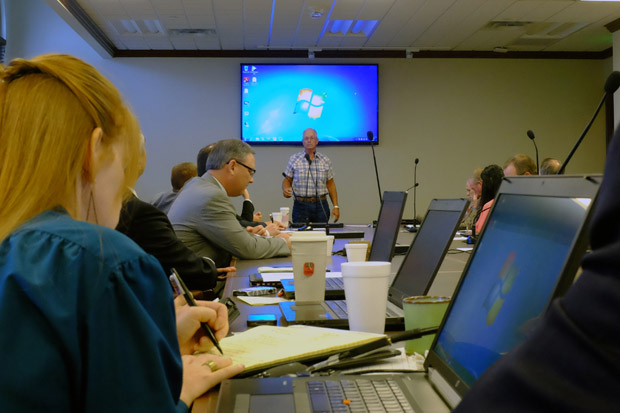
Jack Klinger, a resident who lives near the Salt Fork River, tells lawmakers about his contaminated water well.
Joe Wertz / StateImpact Oklahoma


Jack Klinger, a resident who lives near the Salt Fork River, tells lawmakers about his contaminated water well.
Joe Wertz / StateImpact Oklahoma

Joe Wertz / StateImpact Oklahoma
Jack Klinger, a resident who lives near the Salt Fork River, tells lawmakers about his contaminated water well.
A state representative from north-central Oklahoma on Tuesday questioned whether the state was properly inspecting oil and gas wells and had the rules necessary to prevent contamination of water supplies.
The remarks by Rep. Steve Vaughan, R-Ponca City, came at a hearing of an interim legislative study on horizontal drilling and hydraulic fracturing on state water supplies.
Vaughan is concerned about saltwater pollution in Kay and Noble Counties, which has had large-scale fish-kills for three years in a row. Local resident Jack Klinger, who has lived near the river for more than 70 years, spoke at the hearing and said his water wells have been contaminated.
“In 2013, our salt and calcium was just a little over 20,” Klinger said. “We had it tested when we couldn’t use our water and it was 2,180 in salt and calcium. So something has to be leaking, something has to be getting into it in order to do that.”
Officials with the Department of Environmental Quality listed oil and gas pollution as a possible cause of the recent fish-kills, which the Oklahoma Corporation Commission — the state’s oil and gas regulator — is now investigating. Tim Baker, who heads the commission’s pollution division, told StateImpact Tuesday that well inspectors surveyed disposal wells and oil and gas sites near the Salt Fork, but found no clear source of the contamination.
“We went out and inspected all the wells along the Salt Fork and did not find any violation, and did not find any leakage of any kind,” Baker said. “We’re not seeing an ongoing pollution source.”
Briny wastewater from oil and gas prodcuction, also known as “produced water,” often contains high levels of salts that are toxic to fish and other wildlife. But the Salt Fork River, which flows into the Arkansas River, is inheriently salty, hence its name, so distinguishing between natrual and artifical sources of salt contaimination is difficult.
Rep. Vaughan said the situation is further complicated because oilfields near the Salt Fork are booming, and they’ve been home to a lot of historical oil and gas production. The combination of new production and old, possibly deteroriated, wells could increase the likelihood of pollution, Vaughan said.
New rules on well integrity testing go into effect later this week, but Vaughan said the Corporation Commission doesn’t have enough field inspectors, a challenge he suggested he and other lawmakers would consider in the 2015 legislative session.